Community Placement Reflection Report: Occupational Therapy, Year 1
VerifiedAdded on 2023/06/10
|7
|1135
|315
Report
AI Summary
This report presents a reflection on a community placement experience in occupational therapy, focusing on a 75-year-old patient at UCCH hospital. The student utilizes the Gibbs reflective cycle to analyze the initial assessment, highlighting the patient's needs and the importance of social worker and physiotherapist involvement. The report details the student's feelings, evaluations, and analysis of the situation, leading to a conclusion about the need for better communication with the patient's family and the hospital management. The action plan emphasizes ongoing communication and the development of assertive skills. The report also addresses the patient's developmental needs, including the provision of assistive devices and caregiver support, and links these to the HCPC Standards of Proficiency and the Code of Ethics, demonstrating the student's understanding of professional conduct and patient-centered care.
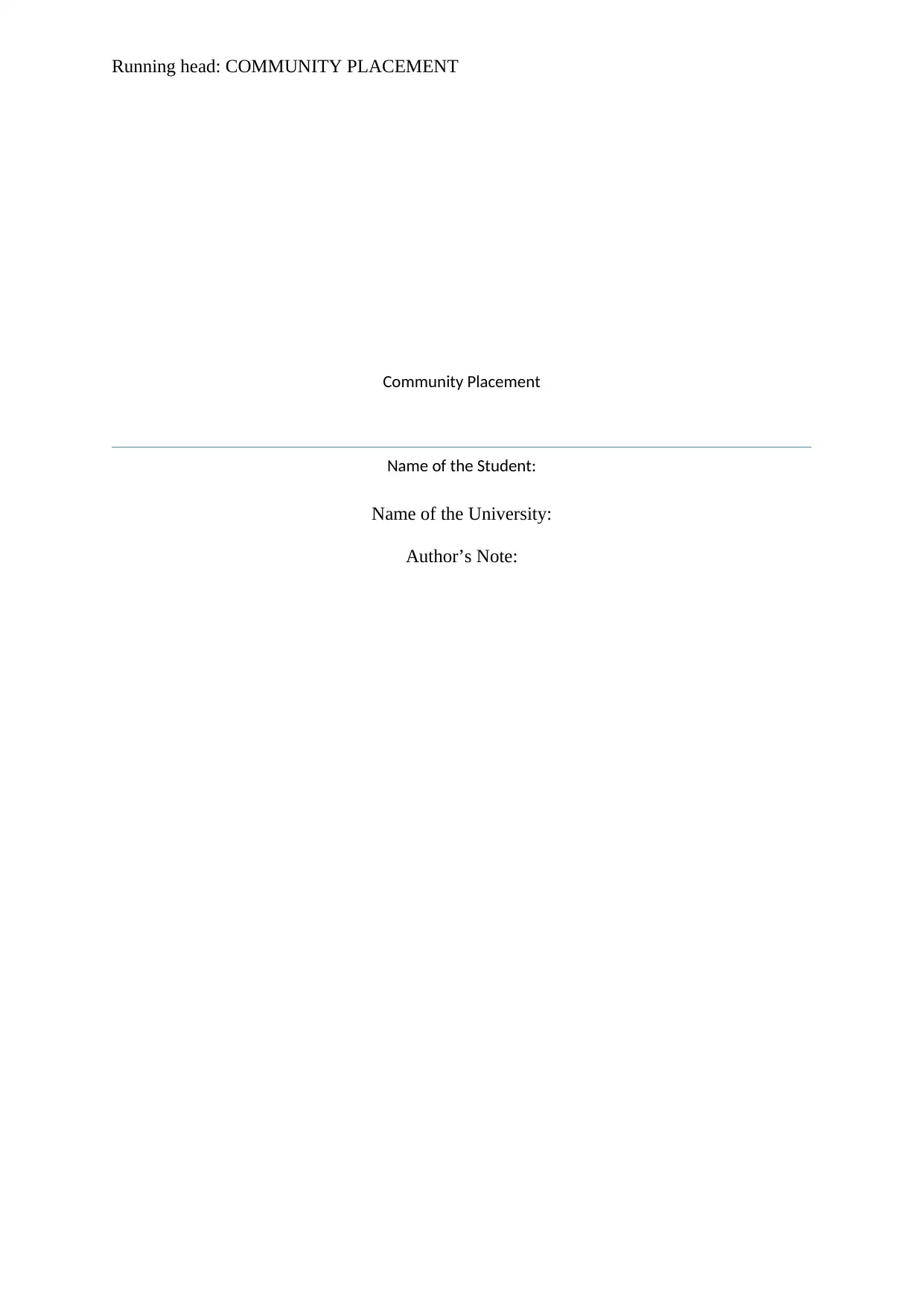
Running head: COMMUNITY PLACEMENT
Community Placement
Name of the Student:
Name of the University:
Author’s Note:
Community Placement
Name of the Student:
Name of the University:
Author’s Note:
Paraphrase This Document
Need a fresh take? Get an instant paraphrase of this document with our AI Paraphraser
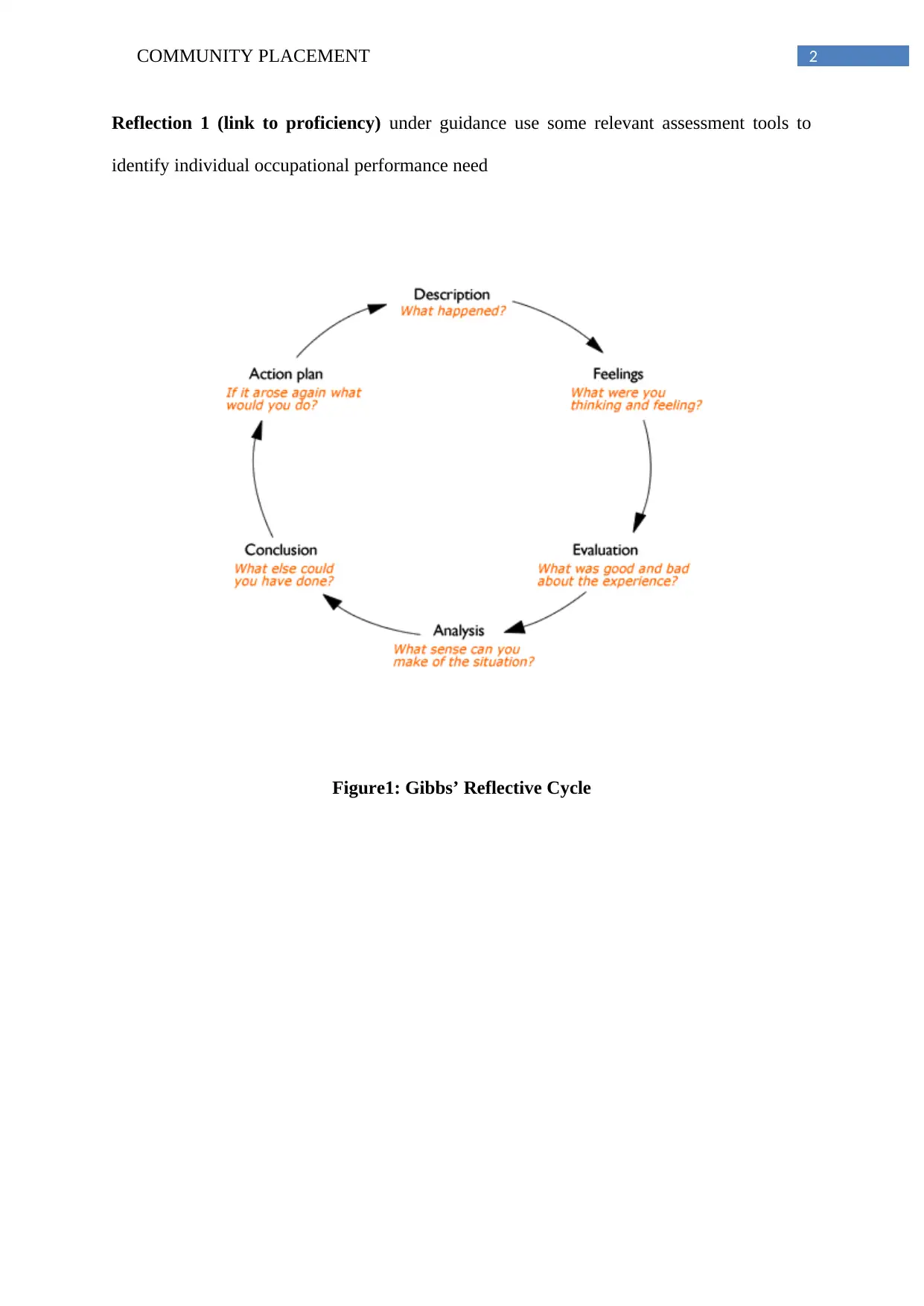
2COMMUNITY PLACEMENT
Reflection 1 (link to proficiency) under guidance use some relevant assessment tools to
identify individual occupational performance need
Figure1: Gibbs’ Reflective Cycle
Reflection 1 (link to proficiency) under guidance use some relevant assessment tools to
identify individual occupational performance need
Figure1: Gibbs’ Reflective Cycle
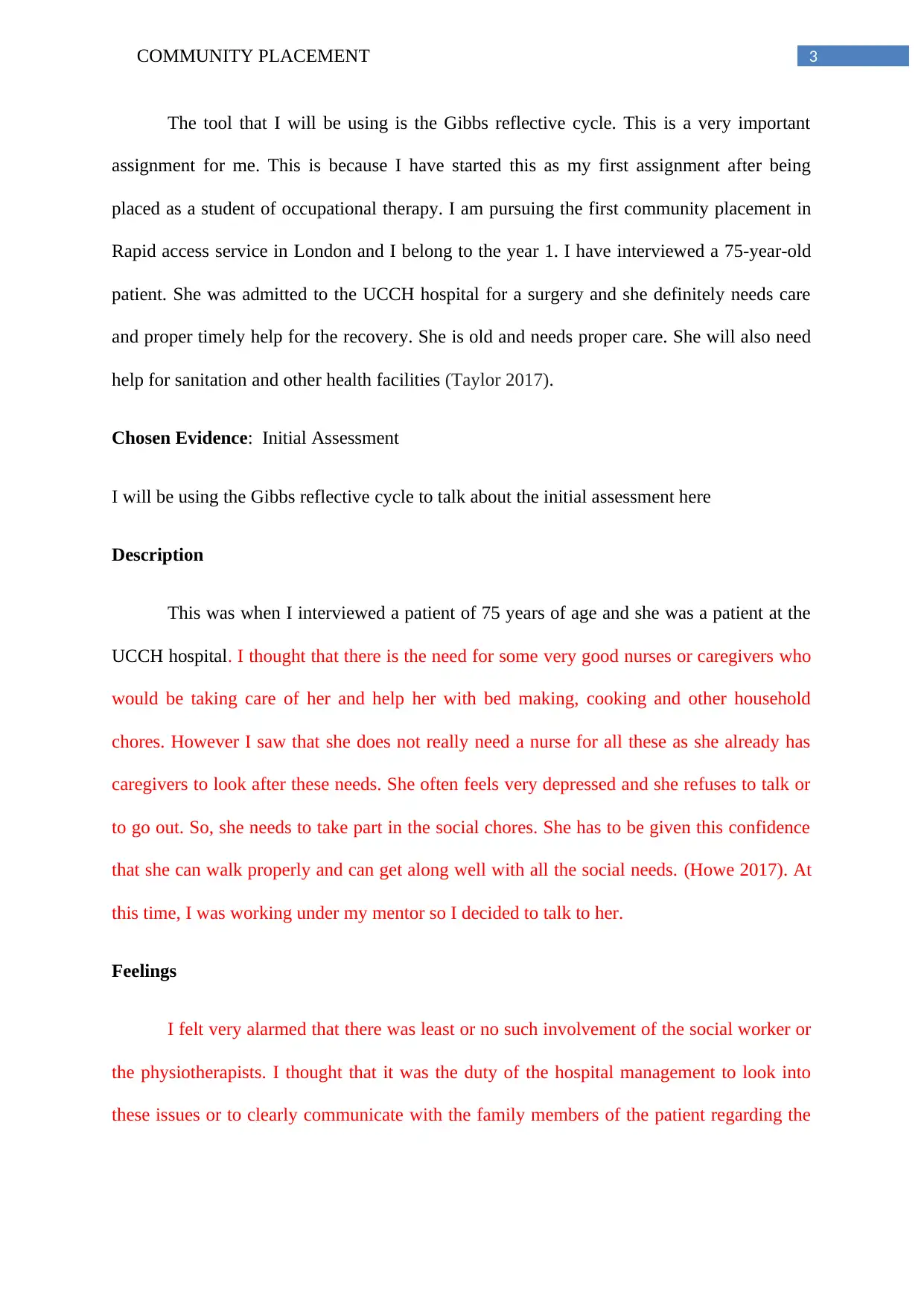
3COMMUNITY PLACEMENT
The tool that I will be using is the Gibbs reflective cycle. This is a very important
assignment for me. This is because I have started this as my first assignment after being
placed as a student of occupational therapy. I am pursuing the first community placement in
Rapid access service in London and I belong to the year 1. I have interviewed a 75-year-old
patient. She was admitted to the UCCH hospital for a surgery and she definitely needs care
and proper timely help for the recovery. She is old and needs proper care. She will also need
help for sanitation and other health facilities (Taylor 2017).
Chosen Evidence: Initial Assessment
I will be using the Gibbs reflective cycle to talk about the initial assessment here
Description
This was when I interviewed a patient of 75 years of age and she was a patient at the
UCCH hospital. I thought that there is the need for some very good nurses or caregivers who
would be taking care of her and help her with bed making, cooking and other household
chores. However I saw that she does not really need a nurse for all these as she already has
caregivers to look after these needs. She often feels very depressed and she refuses to talk or
to go out. So, she needs to take part in the social chores. She has to be given this confidence
that she can walk properly and can get along well with all the social needs. (Howe 2017). At
this time, I was working under my mentor so I decided to talk to her.
Feelings
I felt very alarmed that there was least or no such involvement of the social worker or
the physiotherapists. I thought that it was the duty of the hospital management to look into
these issues or to clearly communicate with the family members of the patient regarding the
The tool that I will be using is the Gibbs reflective cycle. This is a very important
assignment for me. This is because I have started this as my first assignment after being
placed as a student of occupational therapy. I am pursuing the first community placement in
Rapid access service in London and I belong to the year 1. I have interviewed a 75-year-old
patient. She was admitted to the UCCH hospital for a surgery and she definitely needs care
and proper timely help for the recovery. She is old and needs proper care. She will also need
help for sanitation and other health facilities (Taylor 2017).
Chosen Evidence: Initial Assessment
I will be using the Gibbs reflective cycle to talk about the initial assessment here
Description
This was when I interviewed a patient of 75 years of age and she was a patient at the
UCCH hospital. I thought that there is the need for some very good nurses or caregivers who
would be taking care of her and help her with bed making, cooking and other household
chores. However I saw that she does not really need a nurse for all these as she already has
caregivers to look after these needs. She often feels very depressed and she refuses to talk or
to go out. So, she needs to take part in the social chores. She has to be given this confidence
that she can walk properly and can get along well with all the social needs. (Howe 2017). At
this time, I was working under my mentor so I decided to talk to her.
Feelings
I felt very alarmed that there was least or no such involvement of the social worker or
the physiotherapists. I thought that it was the duty of the hospital management to look into
these issues or to clearly communicate with the family members of the patient regarding the
⊘ This is a preview!⊘
Do you want full access?
Subscribe today to unlock all pages.

Trusted by 1+ million students worldwide
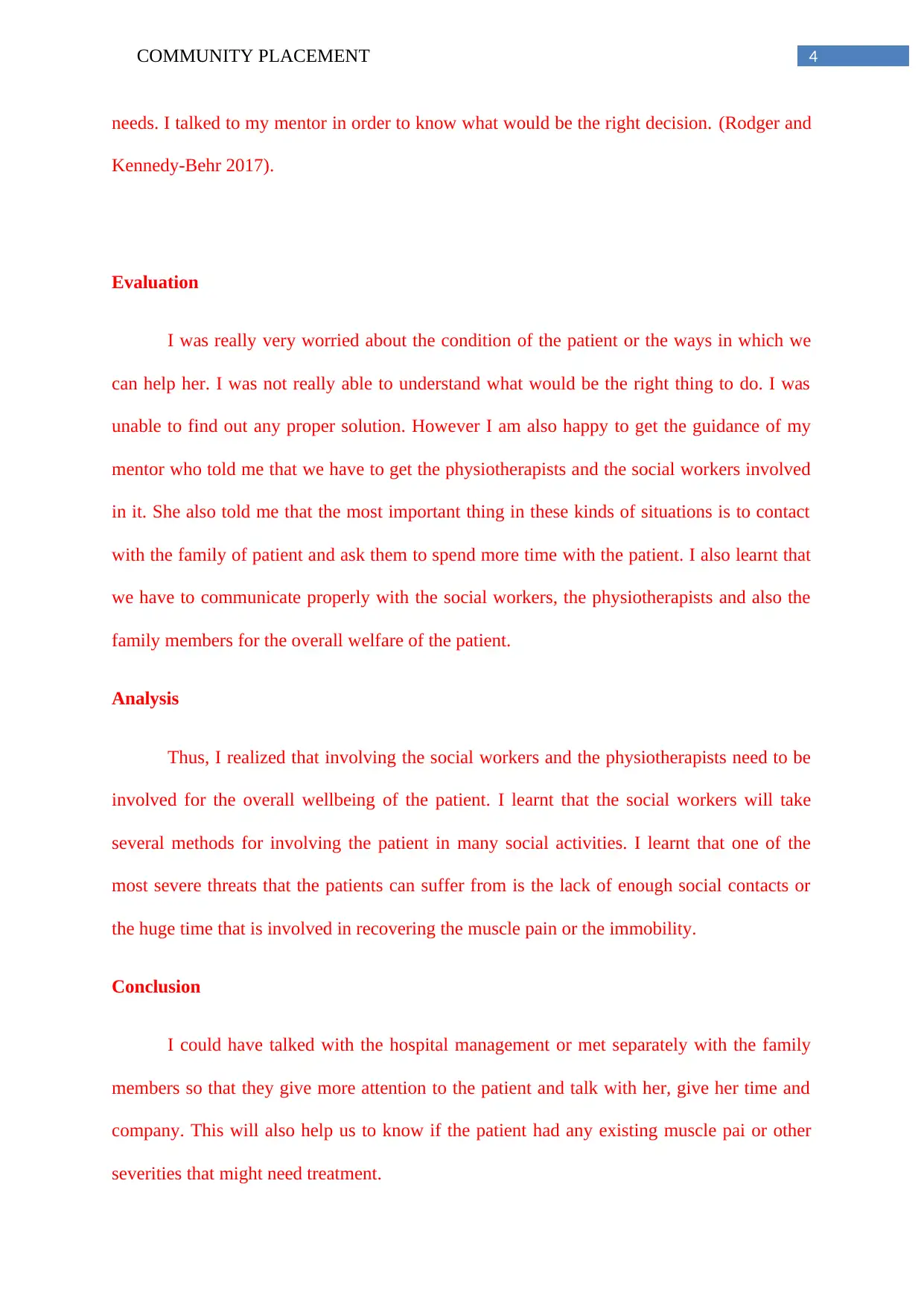
4COMMUNITY PLACEMENT
needs. I talked to my mentor in order to know what would be the right decision. (Rodger and
Kennedy-Behr 2017).
Evaluation
I was really very worried about the condition of the patient or the ways in which we
can help her. I was not really able to understand what would be the right thing to do. I was
unable to find out any proper solution. However I am also happy to get the guidance of my
mentor who told me that we have to get the physiotherapists and the social workers involved
in it. She also told me that the most important thing in these kinds of situations is to contact
with the family of patient and ask them to spend more time with the patient. I also learnt that
we have to communicate properly with the social workers, the physiotherapists and also the
family members for the overall welfare of the patient.
Analysis
Thus, I realized that involving the social workers and the physiotherapists need to be
involved for the overall wellbeing of the patient. I learnt that the social workers will take
several methods for involving the patient in many social activities. I learnt that one of the
most severe threats that the patients can suffer from is the lack of enough social contacts or
the huge time that is involved in recovering the muscle pain or the immobility.
Conclusion
I could have talked with the hospital management or met separately with the family
members so that they give more attention to the patient and talk with her, give her time and
company. This will also help us to know if the patient had any existing muscle pai or other
severities that might need treatment.
needs. I talked to my mentor in order to know what would be the right decision. (Rodger and
Kennedy-Behr 2017).
Evaluation
I was really very worried about the condition of the patient or the ways in which we
can help her. I was not really able to understand what would be the right thing to do. I was
unable to find out any proper solution. However I am also happy to get the guidance of my
mentor who told me that we have to get the physiotherapists and the social workers involved
in it. She also told me that the most important thing in these kinds of situations is to contact
with the family of patient and ask them to spend more time with the patient. I also learnt that
we have to communicate properly with the social workers, the physiotherapists and also the
family members for the overall welfare of the patient.
Analysis
Thus, I realized that involving the social workers and the physiotherapists need to be
involved for the overall wellbeing of the patient. I learnt that the social workers will take
several methods for involving the patient in many social activities. I learnt that one of the
most severe threats that the patients can suffer from is the lack of enough social contacts or
the huge time that is involved in recovering the muscle pain or the immobility.
Conclusion
I could have talked with the hospital management or met separately with the family
members so that they give more attention to the patient and talk with her, give her time and
company. This will also help us to know if the patient had any existing muscle pai or other
severities that might need treatment.
Paraphrase This Document
Need a fresh take? Get an instant paraphrase of this document with our AI Paraphraser
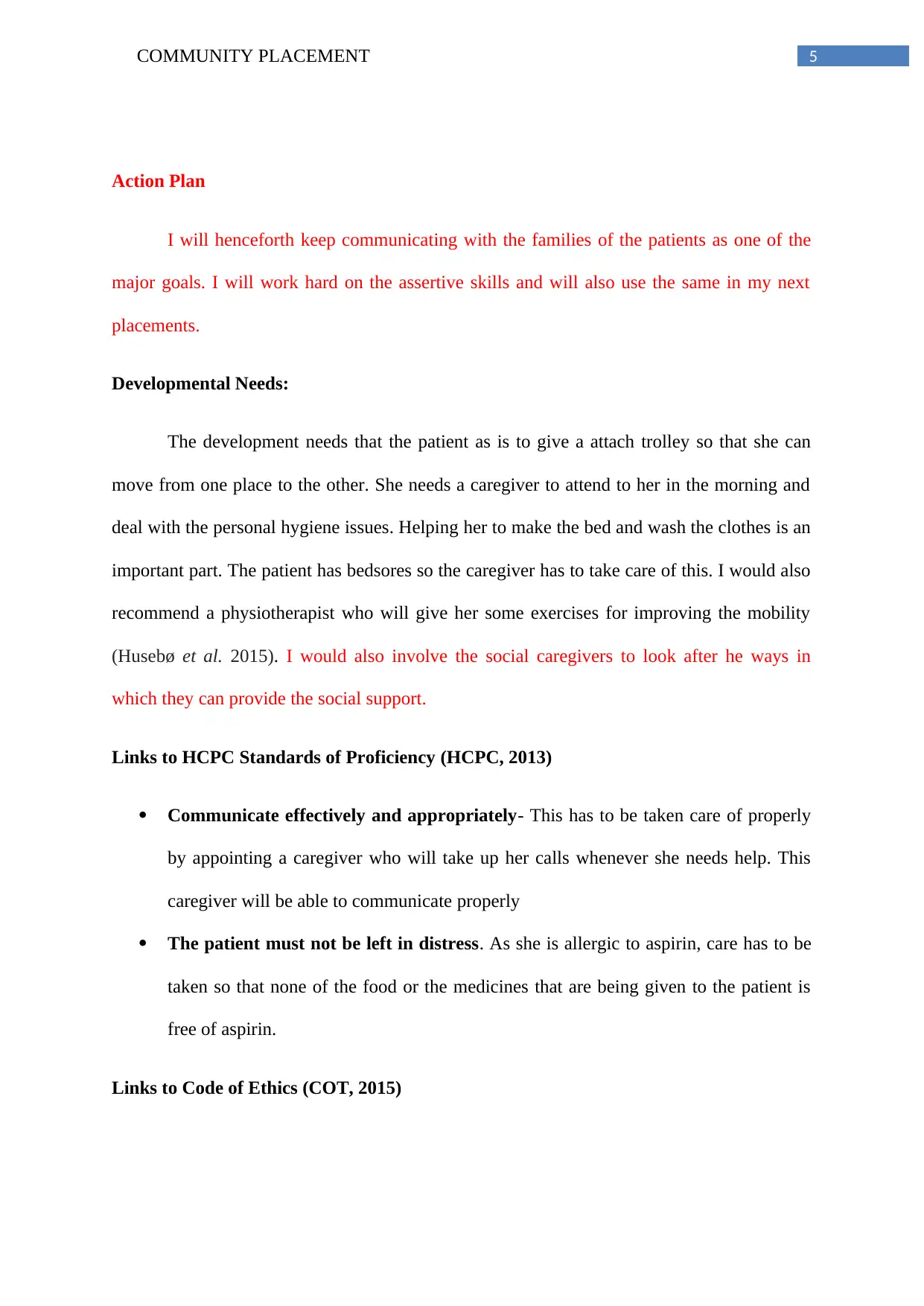
5COMMUNITY PLACEMENT
Action Plan
I will henceforth keep communicating with the families of the patients as one of the
major goals. I will work hard on the assertive skills and will also use the same in my next
placements.
Developmental Needs:
The development needs that the patient as is to give a attach trolley so that she can
move from one place to the other. She needs a caregiver to attend to her in the morning and
deal with the personal hygiene issues. Helping her to make the bed and wash the clothes is an
important part. The patient has bedsores so the caregiver has to take care of this. I would also
recommend a physiotherapist who will give her some exercises for improving the mobility
(Husebø et al. 2015). I would also involve the social caregivers to look after he ways in
which they can provide the social support.
Links to HCPC Standards of Proficiency (HCPC, 2013)
Communicate effectively and appropriately- This has to be taken care of properly
by appointing a caregiver who will take up her calls whenever she needs help. This
caregiver will be able to communicate properly
The patient must not be left in distress. As she is allergic to aspirin, care has to be
taken so that none of the food or the medicines that are being given to the patient is
free of aspirin.
Links to Code of Ethics (COT, 2015)
Action Plan
I will henceforth keep communicating with the families of the patients as one of the
major goals. I will work hard on the assertive skills and will also use the same in my next
placements.
Developmental Needs:
The development needs that the patient as is to give a attach trolley so that she can
move from one place to the other. She needs a caregiver to attend to her in the morning and
deal with the personal hygiene issues. Helping her to make the bed and wash the clothes is an
important part. The patient has bedsores so the caregiver has to take care of this. I would also
recommend a physiotherapist who will give her some exercises for improving the mobility
(Husebø et al. 2015). I would also involve the social caregivers to look after he ways in
which they can provide the social support.
Links to HCPC Standards of Proficiency (HCPC, 2013)
Communicate effectively and appropriately- This has to be taken care of properly
by appointing a caregiver who will take up her calls whenever she needs help. This
caregiver will be able to communicate properly
The patient must not be left in distress. As she is allergic to aspirin, care has to be
taken so that none of the food or the medicines that are being given to the patient is
free of aspirin.
Links to Code of Ethics (COT, 2015)
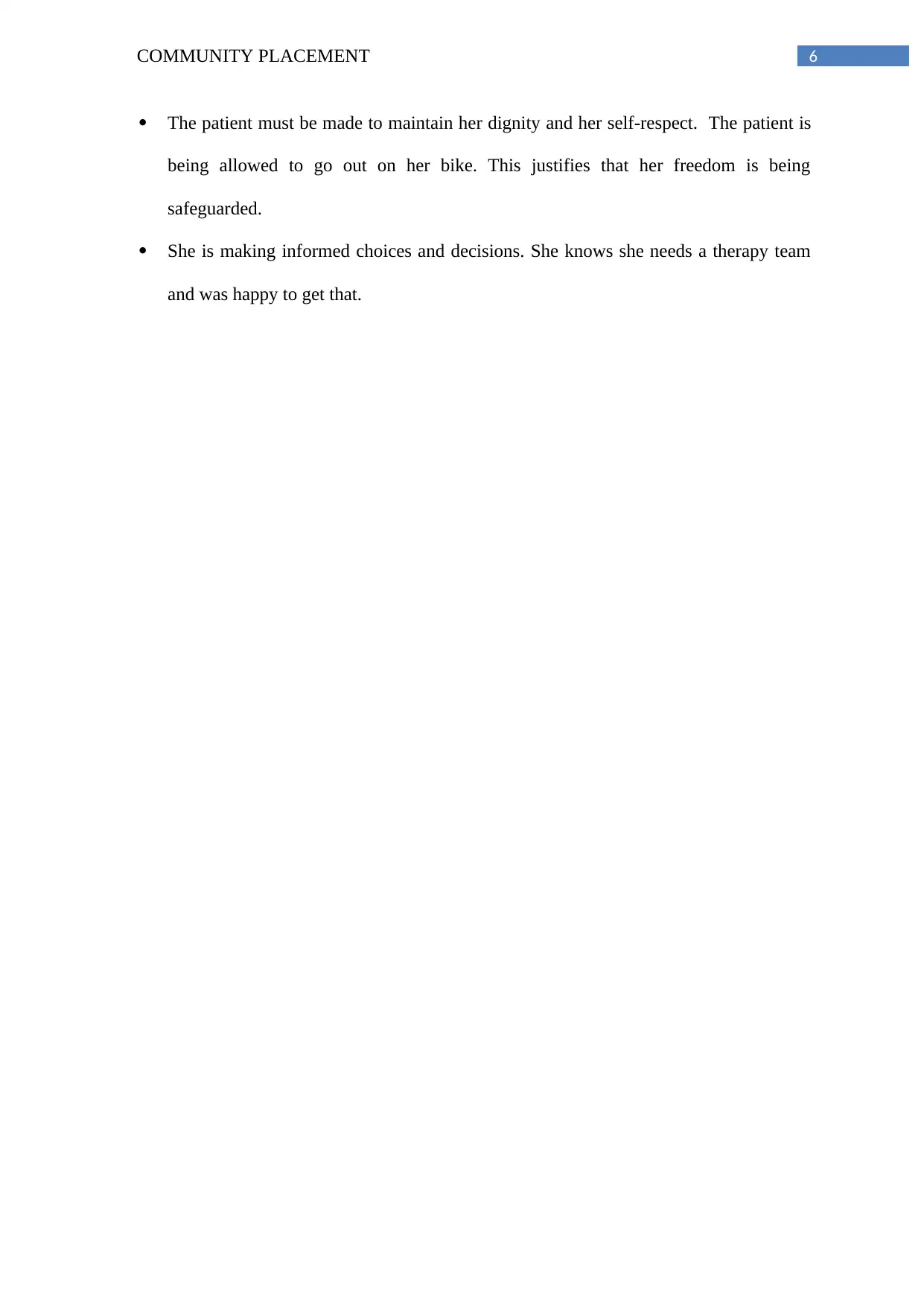
6COMMUNITY PLACEMENT
The patient must be made to maintain her dignity and her self-respect. The patient is
being allowed to go out on her bike. This justifies that her freedom is being
safeguarded.
She is making informed choices and decisions. She knows she needs a therapy team
and was happy to get that.
The patient must be made to maintain her dignity and her self-respect. The patient is
being allowed to go out on her bike. This justifies that her freedom is being
safeguarded.
She is making informed choices and decisions. She knows she needs a therapy team
and was happy to get that.
⊘ This is a preview!⊘
Do you want full access?
Subscribe today to unlock all pages.

Trusted by 1+ million students worldwide
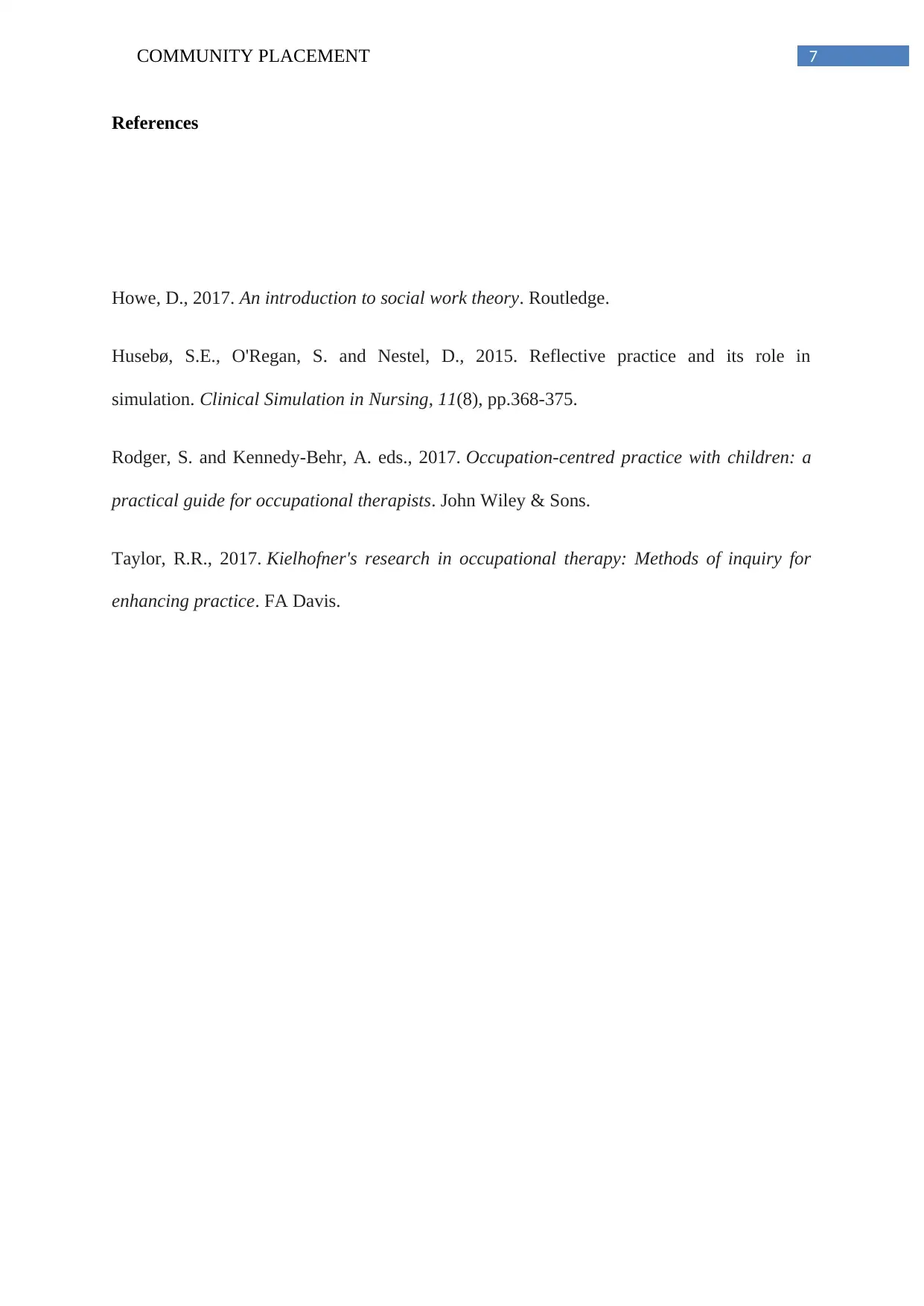
7COMMUNITY PLACEMENT
References
Howe, D., 2017. An introduction to social work theory. Routledge.
Husebø, S.E., O'Regan, S. and Nestel, D., 2015. Reflective practice and its role in
simulation. Clinical Simulation in Nursing, 11(8), pp.368-375.
Rodger, S. and Kennedy-Behr, A. eds., 2017. Occupation-centred practice with children: a
practical guide for occupational therapists. John Wiley & Sons.
Taylor, R.R., 2017. Kielhofner's research in occupational therapy: Methods of inquiry for
enhancing practice. FA Davis.
References
Howe, D., 2017. An introduction to social work theory. Routledge.
Husebø, S.E., O'Regan, S. and Nestel, D., 2015. Reflective practice and its role in
simulation. Clinical Simulation in Nursing, 11(8), pp.368-375.
Rodger, S. and Kennedy-Behr, A. eds., 2017. Occupation-centred practice with children: a
practical guide for occupational therapists. John Wiley & Sons.
Taylor, R.R., 2017. Kielhofner's research in occupational therapy: Methods of inquiry for
enhancing practice. FA Davis.
1 out of 7
Related Documents
Your All-in-One AI-Powered Toolkit for Academic Success.
+13062052269
info@desklib.com
Available 24*7 on WhatsApp / Email
![[object Object]](/_next/static/media/star-bottom.7253800d.svg)
Unlock your academic potential
Copyright © 2020–2025 A2Z Services. All Rights Reserved. Developed and managed by ZUCOL.





